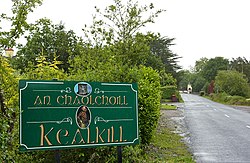Kealkill An Chaolchoill | |
|---|---|
Village | |
 Signage at Kealkill village | |
| Coordinates: 51°45′03″N09°22′49″W / 51.75083°N 9.38028°W | |
| Country | Ireland |
| Province | Munster |
| County | County Cork |
| Time zone | UTC+0 (WET) |
| • Summer (DST) | UTC-1 (IST (WEST)) |
Kealkill (Irish : An Chaolchoill) [1] is a small village in County Cork, Ireland, located 10.3 kilometres from Bantry and 75.8 kilometres from Cork City. Its amenities include a church, a shop, a school, a community playgroup, two public houses and a GAA club (St Colum's).

